.
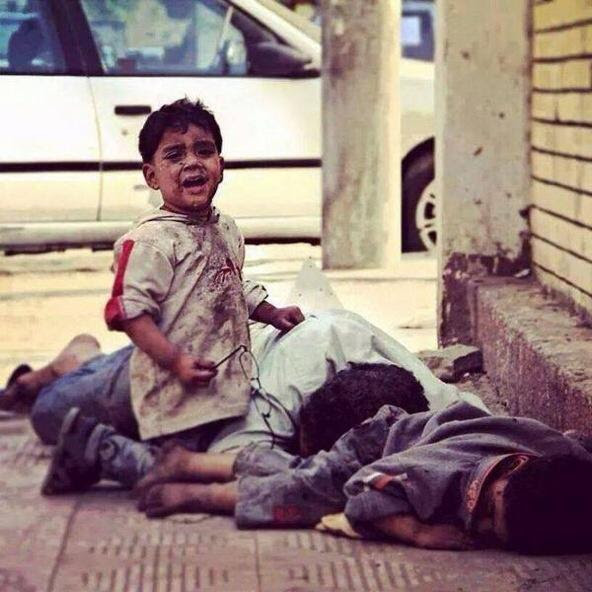
Boy survives, father and brother killed by Israeli bombing, Gaza. How is he going to be normal after this?: photo via Dr Bassel Abuwarda on twitter, 1 August 2014

Happening now -- huge missile strike on Islamic University of Gaza: screenshot by We Support Gaza via twitter, 2 August 2014

Injured Palestinian children at al-Najar hospital in Rafah, southern Gaza, following an Israeli military strike on 1 August: photo by Eyad Al Baba / APA, 1 August 2014
The Hannibal Directive
.......Massive
Israel bombardments now in the southern Gaza Strip in attempt to
prevent IDF captive being spirited away (Hannibal directive)
.......Anshel Pfeffer on twitter 3:46 AM - 1 Aug 2014
A column of Israeli tanks stops briefly alongside a main road in southern Israel, near the Gaza Strip border, as it moves towards Gaza, photo by Jim Hollander / EPA, 1 August 2014
Who Is Behind Gaza's Mass Execution in Khuzaa?

Khuzaa: Piled in one room in the Gaza war zone are rotting bodies -- and shell casings marked “IMI,” short for “Israel Military Industries”: photo by Lazar Simeonov for The Daily Beast, 1 August 2014
KHUZAA,
Gaza — In a small bathroom on the edge of the Gaza town of Khuzaa there
are the haunting signs of what looks like the summary execution of
several Palestinians. This once vibrant village near the border with
Israel sits on the edge of the city of Khan Younis, but it is well
within the 1.8-mile “buffer zone” that Israel has turned into a no-man’s
land. It has been inaccessible for weeks as Israeli bombardment and
troops try to take out heavy guerrilla resistance. Now all that’s left
is rubble, bombed-out buildings and the all-encompassing, sickening
smell of death.
The temporary ceasefire announced Thursday night
was supposed to give the residents of places like this time to return
home, take stock of the damage and collect belongings. But the “72-hour”
ceasefire broke down after 90 minutes, and as I walked through the main
street, where pieces of humans were visible beneath homes and stores,
the constant thud of exploding Israeli shells grew closer and closer.
As
I reach the berm of sand, tile and stucco that marked a kind of front
line, bodies are being piled on carts in the street. Near the ruins of a
demolished store, the black ammunition vests worn by Palestinian
fighters lie in tatters as if hastily stripped off. There are no bodies
or weapons nearby.
Suddenly journalists and local residents are
shouting from a house on the edge of the front. The small family home is
still intact but the stench of rotting flesh that comes from inside is
overpowering.
A barefoot corpse in camouflaged khakis is being
carried into the street, partially wrapped in rug, as I enter the house.
His partly burned and partly decomposing face is unrecognizable as
anyone who was ever alive and breathing. Witnesses say there were at
least six bodies piled together inside this one tiled room where the air
is poisonous with decay.

People recovering the last body from the room where villagers say the mass execution has taken place: photo by Lazar Simeonov for The Daily Beast, 1 August 2014
Blood
and blackened remnants are caked on the bathroom floor. The walls have
been drenched in blood and they are pocked with scores of bullet holes
that look as if they were fired from an automatic weapon at waist level.
Some of the bullet holes are in line, as if the gun were sweeping
across its targets. There is also soot staining the tiles, suggesting
the bodies were burned or there had been a small blast. Several tiles
have fallen away from the wall. The house is filled with casings from
the bullets used in assault rifles. They are marked on the bottom as
“IMI” (Israel Military Industries).
What happened here? It is the
kind of place and the kind of incident that may be studied for years. We
may hear that the Palestinians were executing suspected collaborators,
or that a lone Israeli soldier went mad and started murdering prisoners.
It could be that members of an Israeli army unit at the center of the
fighting decided to take out their rage on those they captured. There
may be many theories. All I can tell you is what I saw and heard at the
scene this day.
Twenty-one-year-old Naban Abu Shaar told me he was one of the first
to find the bodies. He said they looked as if they were “melted” and
piled on top of each other.
“When we entered the bathroom, I found
the bodies of people slumped on top of each other in the corner,” he
said, staring into the distance as if disconnected from his words.
The
owner of the house, Mohammad Abu Al Sharif, said he couldn’t recognize
the bodies but believed, because of their clothes, some of the dead may
have been from his family. He did not say if any of them were fighters.
The house had nine members living in it before Abu Al Sharif, his wife
and four daughters escaped Khuzaa 20 days ago. He lost contact with
those who stayed, he said.
In the streets around, some residents
pulled clothes and blankets from the crushed concrete of obliterated
homes while others used farming tools to unearth the dead. Shell-shocked
women stumbled down the pulverized road, wiping sweat and tears with
their hejabs as they cursed—to no one in particular -- both Palestinian
Authority President Mahmoud Abbas and Egyptian President Abdel Fattah al
Sisi for not protecting them from Israel.
The signs of the
panicked flight almost three weeks ago were apparent everywhere in town.
Neatly hung laundry still dangled over the main street from the
second-floor balcony of an apartment above a blown-out storefront.
Khalid
al Najar, 27, was half dazed as he walked back toward Khan Younis with a
plastic bag of clothes. This is his first time returning home since he
fled nearly three weeks ago. “I’m from a place that used to be called
Khuzaa,” he told me.
Jesse Rosenfeld, The Daily Beast, 1 August 2014
62 martyrs in Rafah since morning: photo by Dr Saeed Marasa on twitter, 1 August 2014
After
the collapse of a 72-hour ceasefire, patients and families are
evacuated from Shifa Hospital when the threat of a bombing was called
in: photo by Carolyn Cole / Los Angeles Times, 2 August 2014
Chickens gather in a kitchen of a destroyed homin Gaza. Many farm animals in the area haven't been fed for more than a week: photo by Carolyn Cole / Los Angeles Times, 2 August 2014
Scientist who studied at Manchester University killed in Israeli shell attack on UN car in Gaza

Dr Bashir al-Hajjar died alongside his younger brother Muneer during the strike in Beer al-Naja in the north of the region. They were travelling in a marked United Nations Relief and Works Agency car when shells landed in front of it and on its bonnet: photo via Manchester Evening News, 1 August 2014
“He was a calm person, he believed in peace. It is a disaster. Why are they doing this?”
A
scientist who studied at Manchester University has been killed after
the UN car he was in was hit during an Israeli military assault on Gaza.
Dr
Bashir al-Hajjar died alongside his younger brother Muneer during the
strike in Beer al-Naja in the north of the region. They were travelling
in a marked United Nations Relief and Works Agency car when shells
landed in front of it and on its bonnet.
Relatives told the M.E.N. how Dr al-Hajjar, a father-of-one, died instantly –- while Muneer, who worked for the UN, lived for six minutes as he begged rescuers to help his brother and not him.
Muneer’s eight-year-old son, also in the vehicle, survived but has been left with serious leg injuries.
Dr al-Hajjar, 47, lived in Rusholme
with wife Iman and daughter Sathia, 13, between 2010 and 2013 while he
completed a PhD in Mental Health Nursing –- writing a thesis on stress
among hospital nurses in Gaza. He has three PhDs and was most recently a
lecturer at the Islamic University of Gaza.

The UNRWA car which was carrying Dr Bashir al-Hajjar, seen here after it was hit in Gaza, killing him and his brother, UN worker Muneer al-Hajjar: photo via Manchester Evening News, 1 August 2014
Dr Ramy Abdu, the Gaza-based chair of human rights group
Euro-mid Observer, became close friends with Dr al-Hajjar as they both
studied in Manchester.
He said: “Bashir didn’t just want to contribute to the knowledge of Palestine, he wanted to contribute to the knowledge of the whole world. He wanted to use the example of Palestine to show everyone how to avoid the suffering we have experienced. He was really intelligent, hard-working, very polite, not involved in politics at all.”
Dr al-Hajjar’s brother-in-law, Iyad, said: “Bashir was not a terrorist, he was not a militant. He was a human being, a scientist travelling in a clearly-marked UN car.”
Dr al-Hajjar was killed on
Tuesday afternoon -– hours before 16 Palestinians died and more than 90
were injured when Israeli tank shells hit a UNRWA school sheltering
refugees in Jabalia.
More than 1,300 Palestinians, mostly civilians, have been killed in 23 days of fighting between Israel and Hamas. More than 50 Israelis, mostly soldiers, have been killed.
The Israel Defence Forces did not provide a comment.
Family
of Dr Bashir al-Hajjar said he had talked of moving back to Britain for
the sake of his daughter in the days before he was killed.
The respected scientist had realised a ‘dream’ after gaining a PhD in Manchester -– and was a well-known and popular member of the city’s academic community.
In recent days, he had started to believe he could no longer keep his family safe in Gaza so talked to brother-in-law Iyad about returning to Britain after Sothia, 13, finished secondary school.
Dr al-Hajjar lived in Beer al-Naja but decided to move back to his family’s home in Jabalia because he believed it would be safer.
He and his brother Muneer, 38, were killed as they travelled to the academic’s house in Beer al-Naja in a UN car to pick up some belongings.
Brother-in-law Iyad broke down in tears as he described how thousands of people attended their funerals in the hours after their deaths.
He added: “It’s a huge loss. Bashir was in the middle of completing research papers on crucial issues. Who is going to finish them now?
“He was a calm person, he believed in peace. It is a disaster. Why are they doing this?”
Manchester Evening News, 1 August 2014
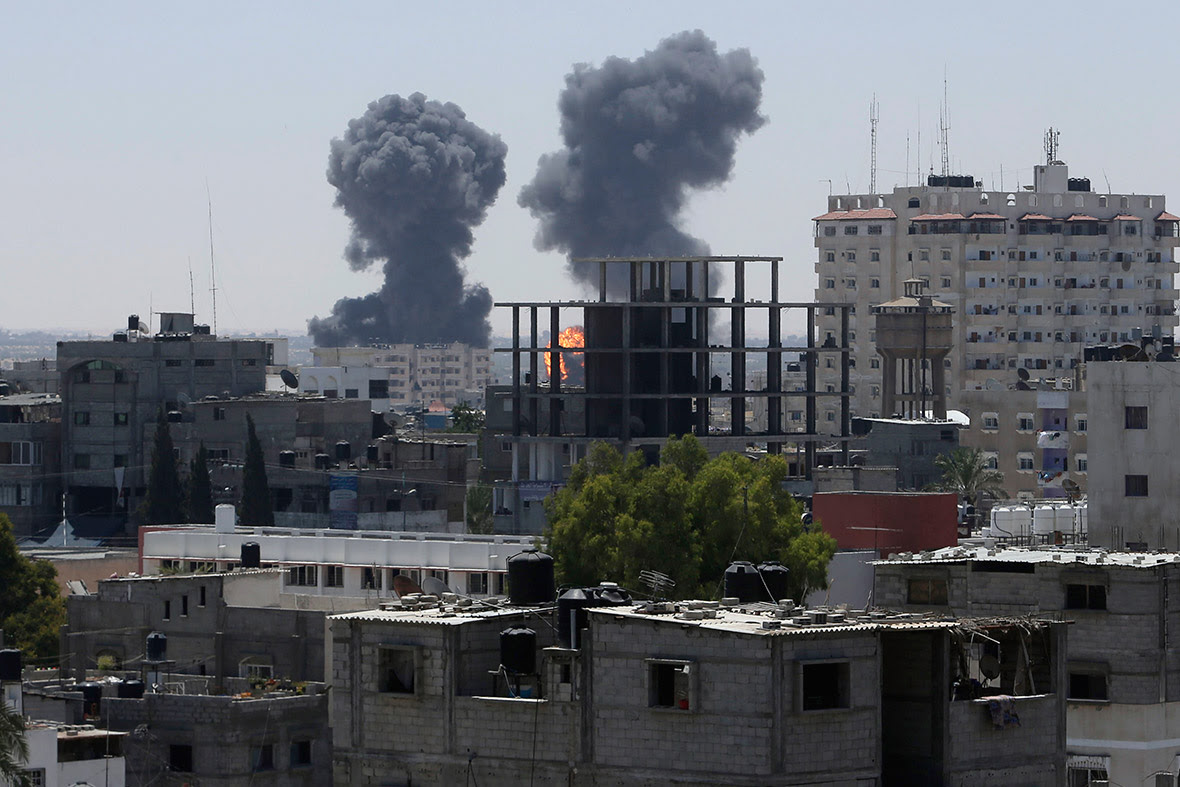
Smoke and flames are seen following what witnesses said were Israeli air strikes in Rafah in the southern Gaza Strip: photo by Reuters, 1 August 2014

Palestinians look at an unexploded Israeli shell that landed on the main road outside the town of Deir Al-Balah in the central Gaza Strip: photo by Reuters, 1 August 2014

Palestinian women inspect the damage to their home in Jabaliya in the northern Gaza Strip: photo by AFP, 1 August 2014
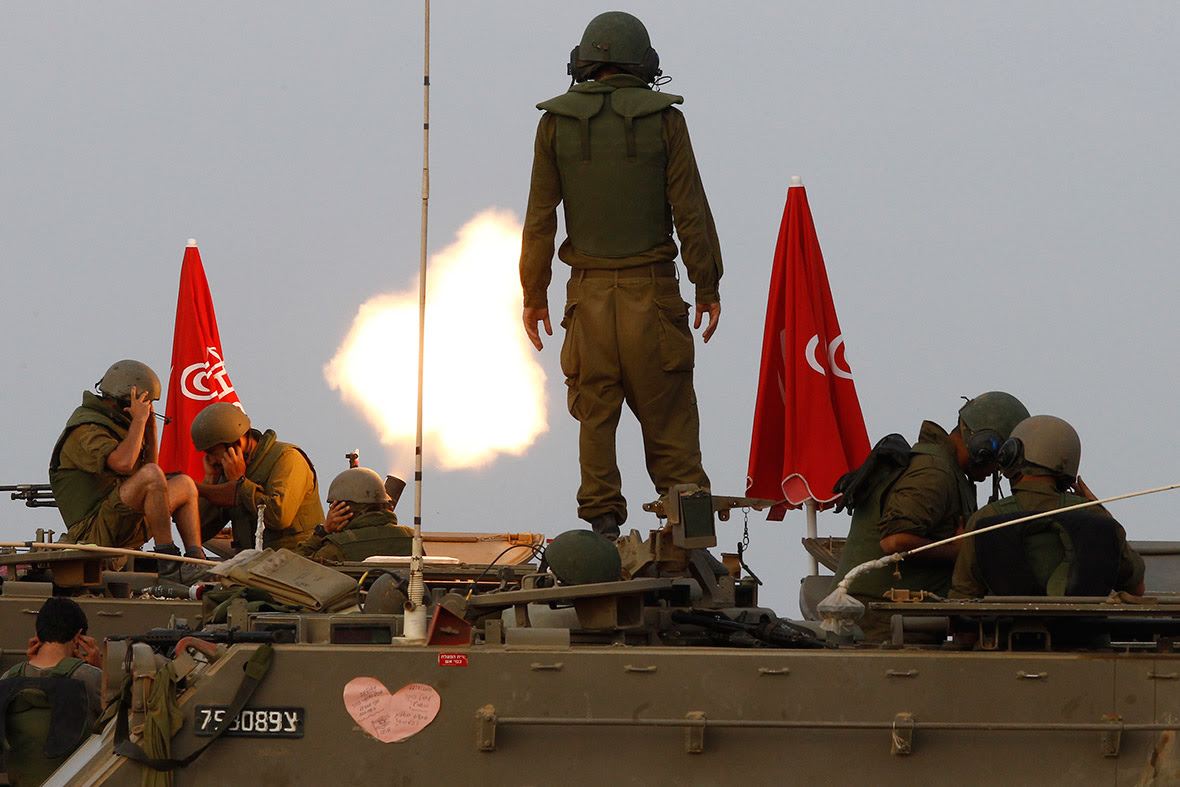
Israeli soldiers stand on an armoured personnel carrier (APC) outside the central Gaza Strip as they fire mortar shell towards Gaza before a ceasefire was due, early on August 1, 2014: photo by Reuters 1 August 2014
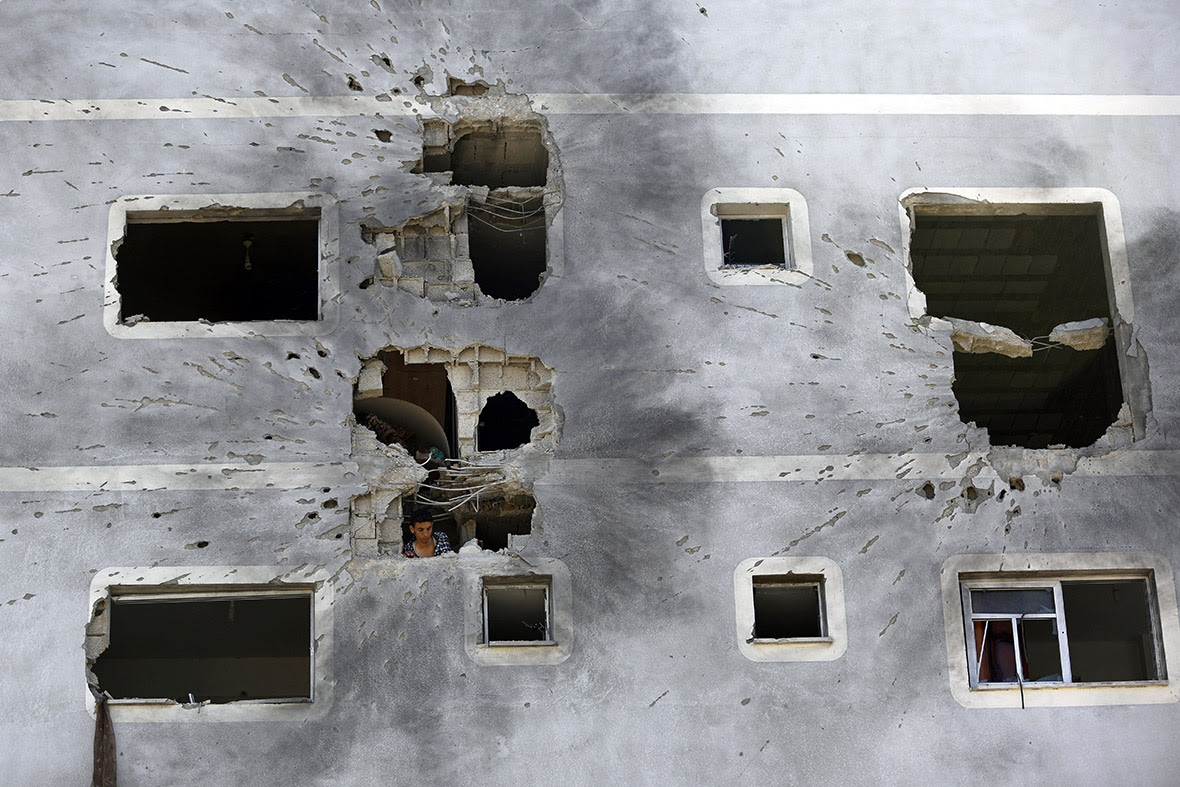
A Palestinian man inspects the damage to his home in Jabaliya in the northern Gaza Strip: photo by AFP, 1 August 2014

A wounded Palestinian woman arrives at al-Najar hospital in the southern Gaza Strip: photo by AFP, 1 August 2014

Palestinians carry the body of a Palestinian after removing it from the rubble in Khan Younis in the southern Gaza Strip: photo by Reuters, 1 August 2014

Palestinians
walk through the rubble of destroyed houses in the east of Khan Younis,
which witnesses said was heavily bombarded in Israeli shelling and air
strikes: photo by Reuters, 1 August 2014
Zero Degrees of Separation
Dr Mads Frederick Gilbert (centre) at Al-Shifa hospital on 14 July 2014, treating a wounded Palestinian child, after an Israeli air strike killed four children and wounded fifty others: photo via Middle East Monitor
Dr. Sara Roy: our own salvation now lies in Gaza’s
A personal and concluding reflection
A personal and concluding reflection
Palestinians in the Gaza Strip are entrapped in what
Professor Nadera Shalhoub-Kevorkian of Hebrew University terms "a zone of
non-existence." In this zone, she argues, one finds "new spaces of obscenity in
the politics of day-to-day lives" where engaging in normal, everyday acts
of living and working -- going to school, visiting neighbors, traveling abroad,
planting a tree, growing vegetables and selling products in a nearby market -- are
treated as criminal activities, punishable, in some instances, by death.
In these obscene spaces, innocent human beings -- most of them, children -- are
slowly
being poisoned by the water they drink, all with the knowledge and acquiescence
of the world community.

Early Model 154 wind tunnel model aerial drone: photographer unknown. n.d. (Ryan Aeronautical Collection, San Diego Air and Space Museum)
This disfigurement of everyday life is, for me,
as a Jew, painfully symbolized in the Star of David that was gouged into Gaza’s
soil during Israel’s 2008 war on the territory. Yet the desecration of the land
in this way not only points to the destruction of a way of life and means of
survival for Palestinians, it embodies the limitations of Israeli power and the
failings of Jewish life as well. No doubt those who wrested the Star of David
from Gaza’s land meant to convey the presence and the power of the Jewish state
over the destiny of others. Yet this power is one of deprivation and ruin, and
it speaks profoundly to our own inability to live a life without the walls we
are constantly asked to build.

Israel has destroyed 80 mosques in Gaza in the past 25 days: photo via Falasteen on twitter, 31 July 2014
As I have hopefully shown, the
people of Gaza are being deliberately targeted and a crime against them is
being
committed. More than anything, this crime is found in the daily and
unrelenting assault on their economy and society for which the United States,
the European Union and various Arab states bear enormous responsibility
together
with Israel. Whether you deliberately shoot a human being through the heart
with
a bullet or deprive him of a home, livelihood, and the means to care for his
children, you are saying to that human being that he has no right to exist. In
this way, among others, Gaza speaks to the unnaturalness of our own condition
as
Jews. For in Gaza, we seek remedy and consolation in the ruin of another
people, "[o]bserving the windows of [their] houses through the sites of
rifles,"
to borrow from the Israeli poet, Almog Behar. It is ironic then that
our own salvation now lies in Gaza’s. And no degree of distance or separation
can ever change that.
Dr. Sara Roy: from the 2012 Edward Said Memorial Lecture sponsored by The Palestine Center, Washington, D.C.: A Deliberate Cruelty: Rendering Gaza Unviable -- On the destruction of Gaza and Its People
Dr. Sara Roy is a senior research scholar at the Center for
Middle Eastern Studies at Harvard University where she completed her doctoral
studies in international development and education. Trained as a political
economist, Dr. Roy has worked in the Gaza Strip and West Bank since 1985
conducting research primarily on the economic, social and political development
of the Gaza Strip and on U.S. foreign aid to the region. Dr. Roy has written
extensively on the Palestinian economy, particularly in Gaza, and has
documented
its development over the last three decades. Her most recent book, Hamas and
Civil Society in Gaza: Engaging the Islamist Social Sector, was published in 2011 by Princeton University
Press. This lecture is drawn from a longer research work that will be
published as a new introduction to the third edition of
her book The Gaza Strip: the Political Economy of De-development from the Institute for Palestine Studies.

A bomb is seen before it hits a house in a Gaza City neighborhood: photo by Max Becherer / Polaris Images for The Washington Post, 31 July 2014
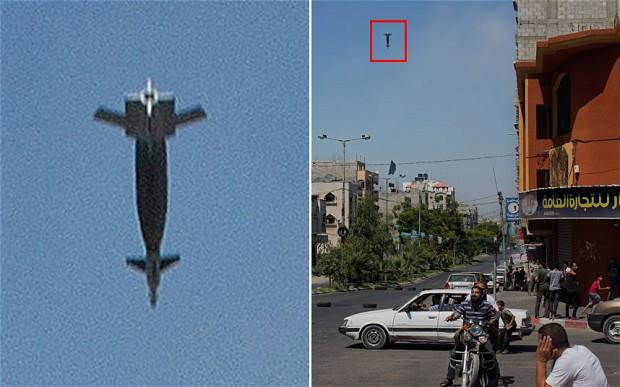
American-made 2,000lb GBU-10 Paveway II laser-guided bomb hitting building in Gaza: photo via Joanne Mariner on twitter, 1 August 2014

An Israeli missile strikes a house in Gaza, minutes after Israeli forces called the owner and asked him to evacuate: photo by Max Becherer / Polaris Images for The Washington Post, 31 July 2014

Smoke rises from a house in a Gaza neighborhood after it is hit by a missile: photo by Max Becherer / Polaris Images for The Washington Post, 31 July 2014
At Gaza mosque ruins with families living among debris
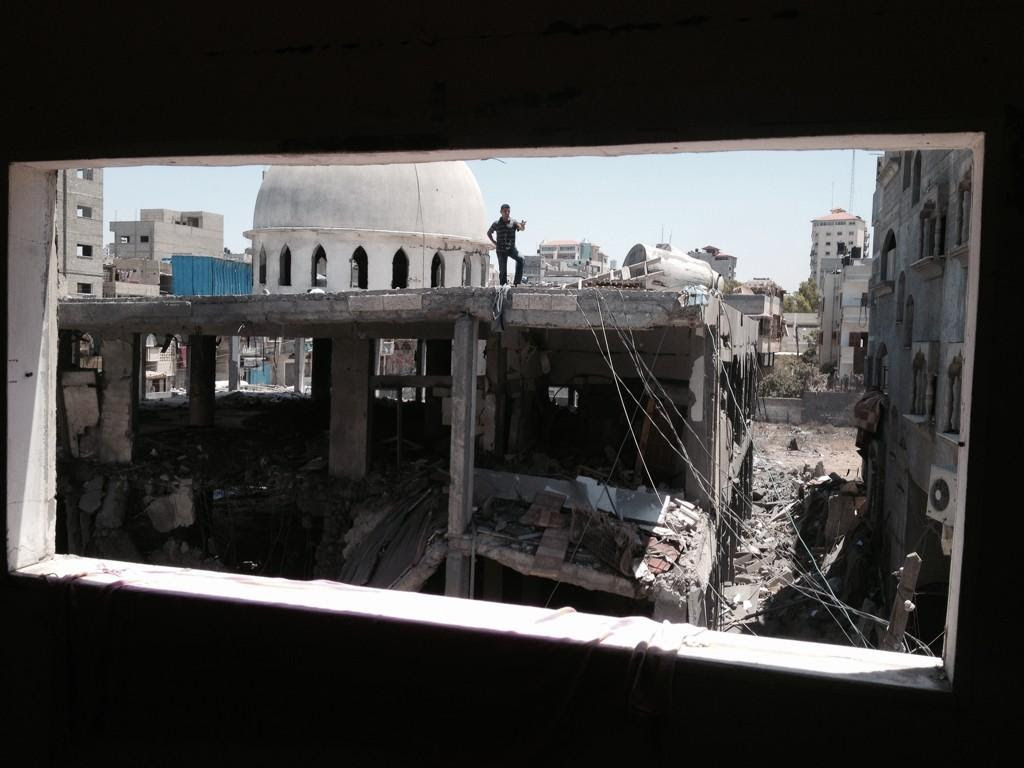
So we visited this blown-up mosque today destroyed in an Israeli air strike...: photo by Stuart Webb, 1 August 2014
The first thing I noticed was a tug at my
arm. I looked down to see a young girl in a blue top smiling up at me.
We
had come to the Al-Shate refugee camp in central Gaza City, to film
where an Israeli strike had hit the Al-Sosi moque a couple of days ago,
destroying it, and collapsing one of the minarets. The tower had
fallen right across the street, taking with it the whole face of an
apartment block opposite.

Bisan 10, has lived through the blockade of Gaza and three wars between Gaza and Israel. "With complete composure she shows me the ruins of her home": photo by Stuart Webb, 1 August 2014
"There!" she said, pointing to the third floor of the
building across the road. The whole face of the block had been
destroyed. From the street below we could see furniture, beds, a
wardrobe.
"Come and see," she said. Her name was Bisan, and she was 10-years-old. Including this conflict, she has already witnessed three wars in the last six years.
"Come and see," she said. Her name was Bisan, and she was 10-years-old. Including this conflict, she has already witnessed three wars in the last six years.
She introduced me to her father Wiam, and we walked upstairs and meet the rest of her family, still living among the debris.

We ask ten yea old old Bisan what it's like to be a child growing up in the war zone that is Gaza: photo by Stuart Webb, 1 August 2014
An Israeli drone had dropped two warning rockets, known as a "knock on roof" on their house at 2.30am, two nights previously. The family was given just five minutes to clear their home.
"It was terrifying, we had to run away so quickly," she told us.
She led us around her bedroom, now a dusty ruin, and showed us the computer where she liked to work. In the living room, three white cats played in the corner among the mattresses where many of the family were now sleeping. Around 30 of them were now crammed into a few rooms.
She led us around her bedroom, now a dusty ruin, and showed us the computer where she liked to work. In the living room, three white cats played in the corner among the mattresses where many of the family were now sleeping. Around 30 of them were now crammed into a few rooms.

Ten year old Bisan was at home with family when the Israeli missiles struck the mosque-part of her home was destroyed...: photo by Stuart Webb, 1 August 2014
In the kitchen, some of the women made bread, while the
younger boys insisted on talking to us about football. "You like Real
Madrid?" her cousin Mohammed asked, wearing a white Madrid shirt
himself. "Sure," I said. He seemed pleased.
Like every family I have met in Gaza, they were warm and
welcoming. Before we left Bisan told us: "My favourite subject is
English, I would like to be a journalist one day."
I hope she gets the chance.
Thom Walker, ITV News, 31 July 2014
A drive through the ruins

There's a whole generation growing up in Gaza scarred by war-seeing and enduring things no child should have to...: photo by Stuart Webb, 1 August 2014
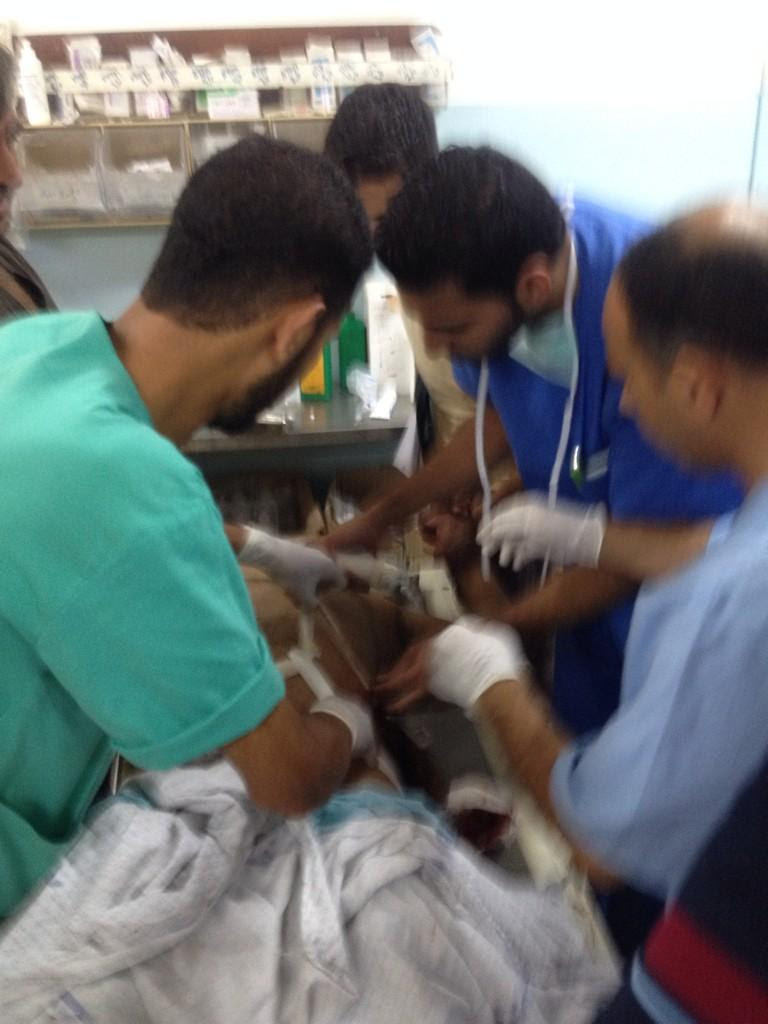
Medical staff working flat out amid chaotic scenes-relatives said this man was shot by an Israeli sniper...: photo by Stuart Webb, 1 August 2014

Gaza casualties were constantly streaming in while we were at Khan Younis hospital...: photo by Stuart Webb, 1 August 2014

At Khan Younis hospital no one knew who this baby belonged to -- injured by shrapnel... Volunteers look after the baby -- staff believe all her relatives were injured by an Israeli shell strike...: photo by Stuart Webb, 1 August 2014

Gaza Hospital staff think the baby was brought in by injured relatives who are now in the operating theatre...: photo by Stuart Webb, 1 August 2014

....bodies carried, bodies on carts and all the while the sound of continuous Israeli shelling filled the air...: photo by Stuart Webb, 1 August 2014

We had Israeli shells scream over our car and detonate close-but we are in a car -- many refugees are caught in the open...: photo by Stuart Webb, 1 August 2014
Fishermen can't fish in their boats-they get shot at by Israeli gunboats-this is the furthest out they can fish: photo by Stuart Webb, 31 July 2014
11: 59 BST
The Guardian's Jason Burke was in the town of Beit Hanoun when the ceasefire began to crumble after just a few hours.
The Guardian's Jason Burke was in the town of Beit Hanoun when the ceasefire began to crumble after just a few hours.
It was quite a heavy night with a fair amount of naval shelling coming in and what sounded like some significant airstrikes but all was quiet after 8am. In Gaza City, fishermen immediately put to sea, cautiously keeping close to the shore, after nearly four weeks without working. There was a general sense of real relief. Most people I spoke to seemed to think the ceasefire would hold.
Up in Beit Hanoun, a town near the northern border of Gaza which has seen sustained bombardment and fighting, hundreds of families were making their way back to find their homes, or what remained of them. A couple of bulldozers were trying to clear some of the streets. Power lines coiled across the streets, amid the putrefying corpses of dead donkeys.
One woman sat sobbing in the rubble. Many people were very angry.
“This is like the second world war, like a nuclear explosion,” said Ahmed Kufurna, 40.
All hoped the ceasefire would hold. “This is the worst and the hardest war I have seen,” said Seehan Nassr, 42. “God willing now it will be peaceful.”
But about 11am, we could hear small arms fire and see what appeared to be strikes from artillery or tank fire around the town’s edges a few hundred metres from where we were.
In Shujai’iya, to the east of Gaza City, the situation and sentiments were similar -- a lot of families heading back to salvage belongings or see what had happened to their homes, and then a rush back for safety when shelling started. As reports of fighting and shelling and casualties in Rafah, down on the Egyptian border, started filtering in, the streets in Gaza City began to empty.
Now we can hear what sounds like artillery fire, possibly from offshore. It’s not as heavy as it was overnight but is fairly steady. The fishermen are gone, except one small boat making its way back in.
The Guardian 1 August 2014
Updated at 2.39pm BST

Palestinian man inspects unexploded shell at side of road in Gaza: photo via Gaza Writes Back on twiter, 1 August 2014
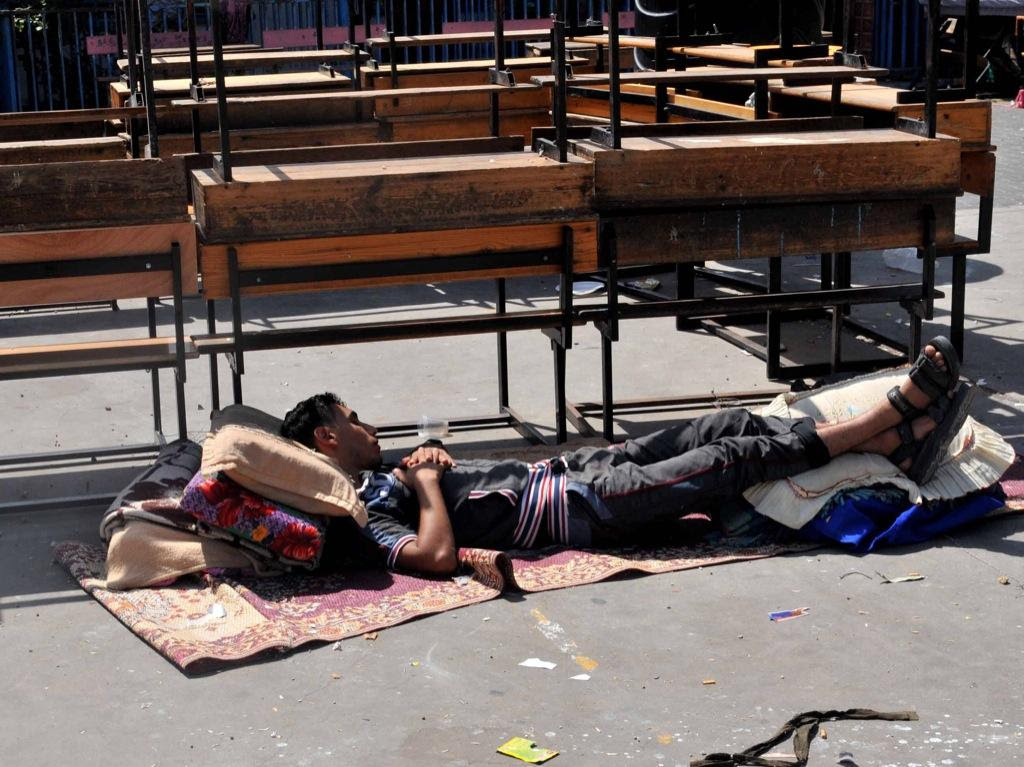

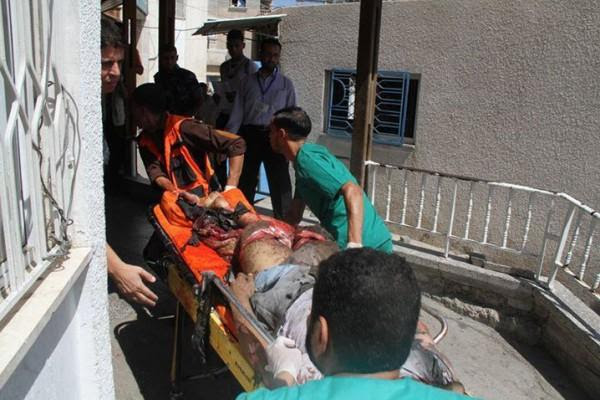

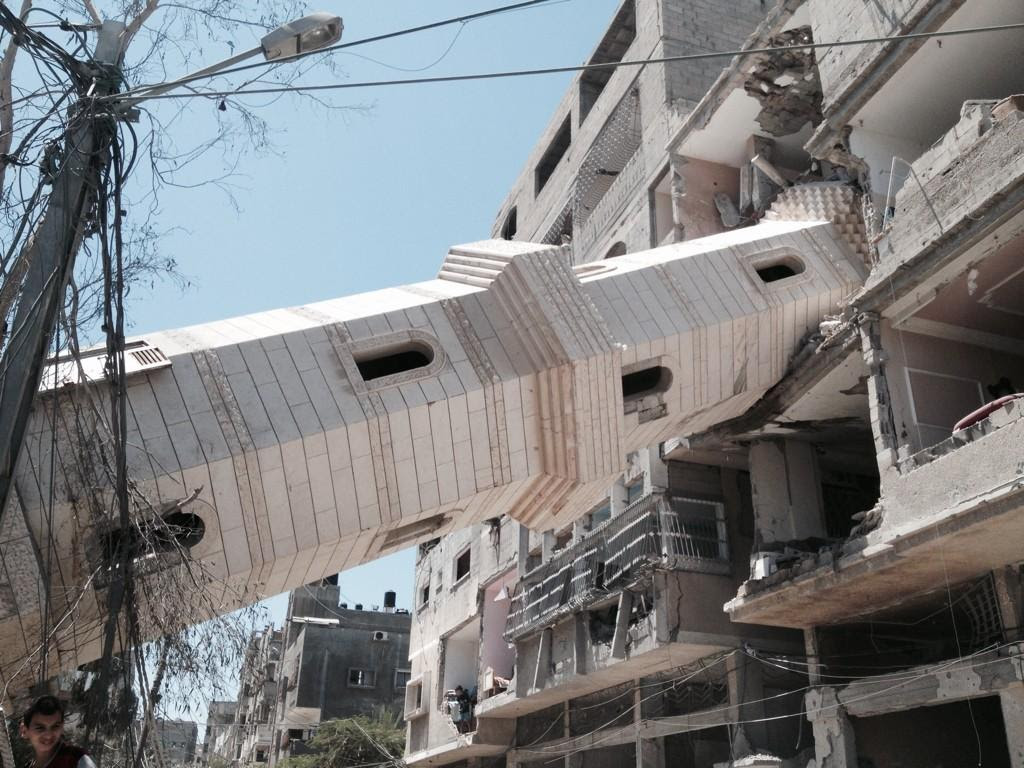
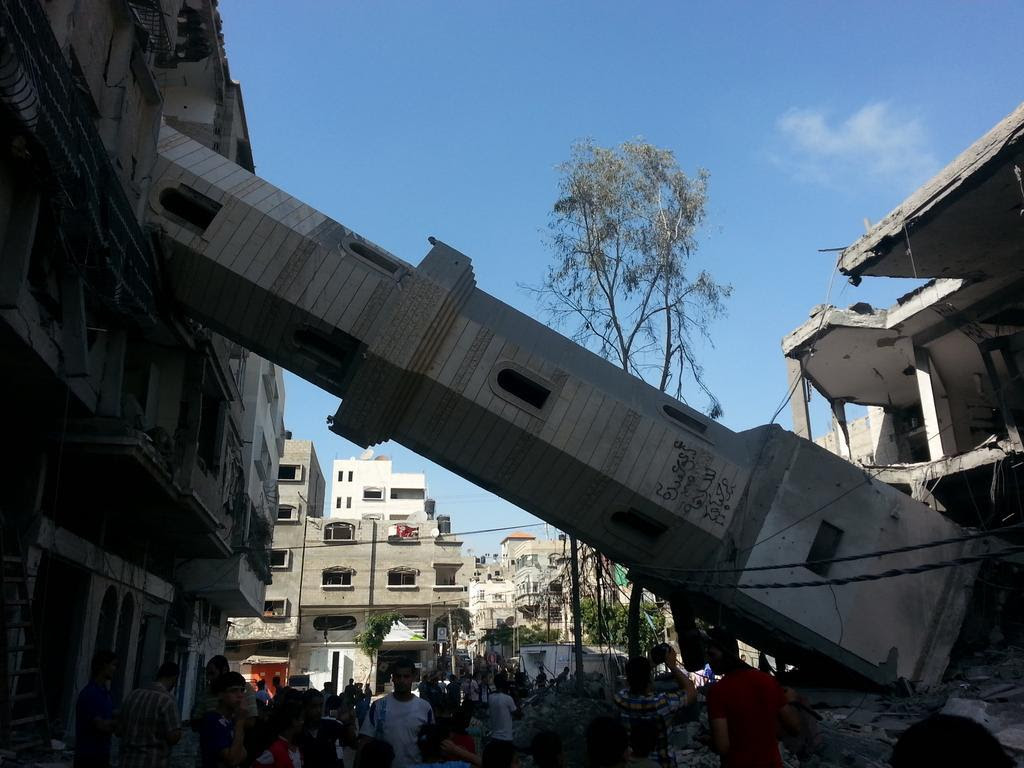


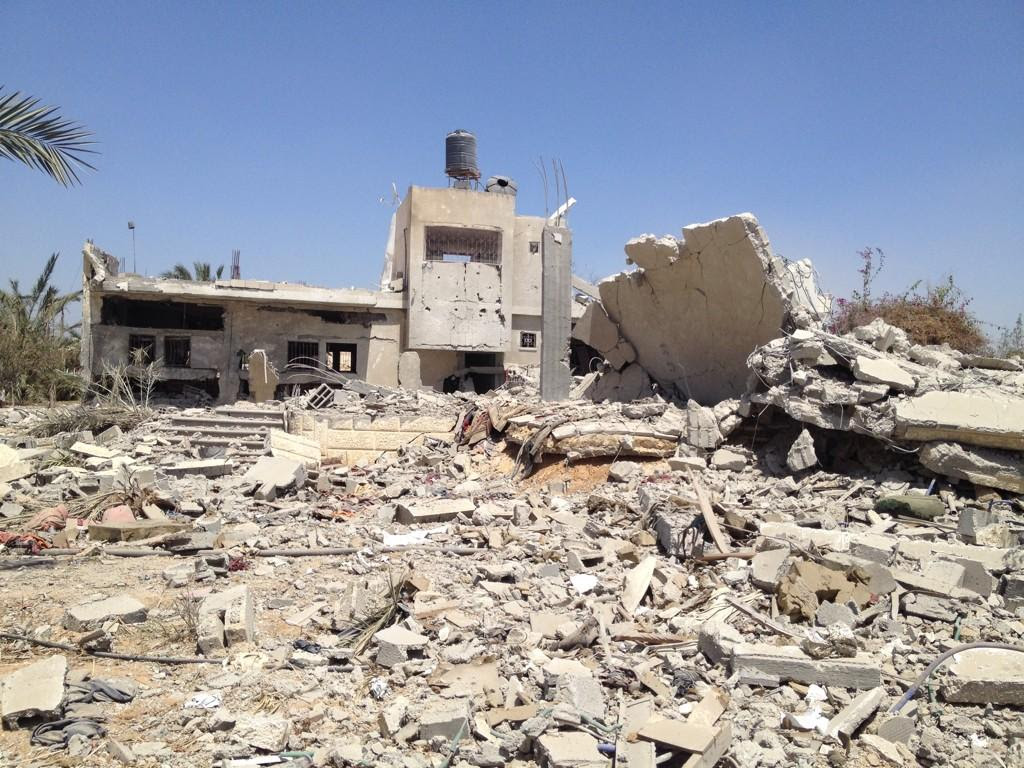






9 comments:
Tom's Blog has very well documented the ugly,cruel, and
inhumane face of war.
Very difficult to take sides in the face of such photos.
However, the people of Gaza elected Hamas who, essentially, proclaims war in its charter. Hamas studied war, prepared for war with offensive means...missiles and tunnels and
then made war and now they are in a war.
Hamas says that Islam will wipe Israel off the face of the map and
since there are 1.5billion Muslims
in the world there's a good chance
of the that happening sometime in
the future. I don't think Israel would go quietly and would take a
a few along with them.
As I have followed this blog since
the inception of this conflict I have not seen one practical suggestion for peace or reconciliation. I do think Tom is
correct about an ultimate war of
revenge. Without the leadership
of the United States...basically
the author of the United Nation's
Four Freedoms and potential guarantor of them in a more ideal
circumstance there is no hope, only war. Now if the shoe were
on the other foot,which it could
easily be one day,do you not think
the Israelis would not be slaughtered?The Christians a few
hundred miles away are being slaughtered, forced to flee, or
subjected to forcible conversion
to Islam.
I think the Irish had an ancient
tradition that their nation could not go to war unless the poets gave it permission. Maybe the solution to the continual wars all over the world is to inject Irish
poets into every nation.
The Jews were taught by Hitler in
Mein Kumpf to treat words as deeds
having, historically, not having
paid the appropriate attention.
So if Hamas calls for the destruction of Israel in its charter do you think Israel should
forget about it?
Style vs substance: Reading Walter
Isaacson's biography of Einstein,he
pointed out that a survey of incoming freshman at Princeton,in 1938
where Einstein was,produced an
astonishing result as to who was the greatest living person: Adolf
Hitler polled first and Einstein
polled second.
And one more thing:New York City
was lucky on 9/11...that the attack was with unconventional
conventional weapons rather than
a weapon of mass destruction. Had
it been a weapon of mass destruction with hundreds of thousands or millions of casualties there would have been
dancing in the streets throughout
areas of the Middle East including
Gaza.
So I hope that as intense is the suffering shown in these photos
that a substance in the middle ground of peace can be found,but
someone will have to look for it.
"....bodies carried, bodies on carts and all the while the sound of continuous Israeli shelling filled the air..."
"This is what the British general Rupert Smith calls “the reality in which the people in the streets and houses and fields –- all the people, anywhere -- are the battlefield”. The Israelis did not go into Gaza to kill children. But, as Jon Snow implied in his passionate video this week, they went in knowing that they would kill children because it is impossible in that crowded, chaotic territory to pursue their foes without massive collateral damage. The only way not to kill children would be not to go in at all. And that raises the most critical issue, which is why they went in. The immediate justification was that Hamas rockets and raiding parties entering through tunnels were a threat to Israeli civilians. One may quarrel with that, because this threat has been, so far, relatively limited. It might get worse in the future, but is a country justified in the use of force because of something that may happen rather than something that has happened? That threat might never fully materialise because of Israeli technical superiority or because political developments rendered it irrelevant.
"The more fundamental reason why Israel went in is not related to what Hamas or Israel has done, but to what Israel has left undone. The distinguished Israeli writer David Grossman, addressing himself to Israeli leaders, asks: “How could you have wasted the years since the last conflict without initiating dialogue, without even making the slightest gesture toward dialogue with Hamas, without attempting to change our explosive reality? Why, for these past few years, has Israel avoided judicious negotiations with the moderate and more conversable sectors of the Palestinian people … Why have you ignored, for 12 years, the Arab League initiative that could have enlisted moderate Arab states with the power to impose, perhaps, a compromise on Hamas?” If you want peace, prepare for war, says the Roman proverb. But here it is the opposite: if you want to avoid war, prepare for peace. The Netanyahu government is paying the price for having sedulously avoided real negotiations with the Palestinians through a long series of subterfuges and distractions culminating in the recent barren passage that, over many months, wore down even the ever-patient and optimistic John Kerry.
"We need a settlement that will mean no repeat of this Gaza operation. A ceasefire is urgent but will fall apart without a broader agreement."
The Guardian, Thursday 31 July 2014
Tom, these pictures are worth 1,000s of words, these words point toward unspeakable horrors . . .
I keep thinking about my father-in-law, who spent his childhood in North London during the Second World War. The house was hit a few times. They ended up with tarpaulin for a roof and about ten people living in a couple of rooms. He remembers seeing St Paul's on fire and can't speak of it without weeping.
Bisan will be marked by what she has seen for the rest of her life.
I've mentioned this before; they make the engines for the drones just outside Birmingham - our part in these children's trauma.
The empty words that dissolve into the same reductive slogans, the omnipresent trauma from which one's first horrified reaction is to draw back. The images of a people broken into the dust, painfully attempting to rise from its knees, hold its head up, feign a bit of the dignity that for seventy years has been taken away, steadily, in increments, then occasionally in these heavy, staggering death-blows.
Those who have come beneath the shadow of suffering can identify without too much trouble.
The "debate" on this "issue", of course, isn't one.
It's hard enough to get through the life without unnecessary exposure to the malignity of agencies like Fox News and CNN.
One doesn't dare attempt to talk back, of course.
Russell Brand: Israel / Palestine: Is this a debate?
As a housebound invalid familiar with physical extremity, it's not too hard for me to imagine the aggravated circumstances of every person living under the Israeli wargasm in Gaza.
Jehad Saftawi, a photojournalist based in Gaza City who works with the Institute for Middle East Understanding, has been hosting a low-end no-frills live feed.
It's a meditative experience. Especially all through the Gaza night.
The roosters are awakened too soon by the pre-dawn shellings and bombings; the dark sky is lit by ominous flashes, the darkness penetrated by distant booms... the images and sounds of twenty-first-century-model one-sided "warfare".
Last night I happened to be watching when a red flash spilled all across the screen, then a distant ball of fire mushroomed upward, pulsating with bright white light for several minutes before slowly fading.
A half hour or so later, reports began to come in. The Israelis had executed a massive strike on the Islamic University of Gaza.
They last attacked the place during he 2008-2009 invasion, when bombing destroyed all the scientific faculties. The rebuilding has been a long slow project. Last night, demolished again, in a matter of minutes.
The destruction of universities, hospitals, mosques, power plants, food plants -- if these acts have any rational purpose apart from instilling terror in a subject people, someone ought to step up and explain that purpose to the world asap.
Amid the glass, twisted metal and shattered concrete lie exercise books and exam papers. An entire wall appears to have been flung 100 metres across a lawn. To one side, someone has placed twisted metal shards – the remains of the Israeli missile which removed almost the entire front of the four-storey administration block of Gaza City's Islamic University in the early hours of Saturday.
"This is simply a place for learning. There is no reason at all for striking it," said Ramir Rahmi, 35, who works in the public relations office of the university, where 22,000 students follow courses ranging from information technology to engineering.
-- Jason Burke, The Guardian, 2 August 2014
Just watched the Russell Brand clip. Very funny and right to the point. As lousy as the news is over here we haven't got a Hannity.
The crude, aggressive, finger pointed in your face "interview" style gets its point across, however unintentionally. The bullying by those who hold power and privilege is chronic and incurable. A sneer is perhaps the best response. But being an ocean away also helps -- over here the Hannitys who don't work for Murdoch are all cops, slamming perps against the bonnets of vehicles.
Their bosses, the corporate defense contractors in particular, are having a field day, what with the volume of weaponry now being employed.
Post a Comment